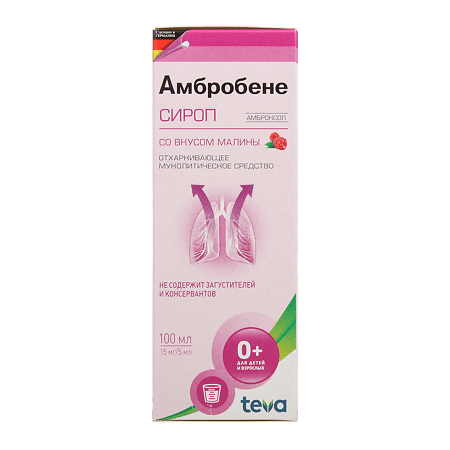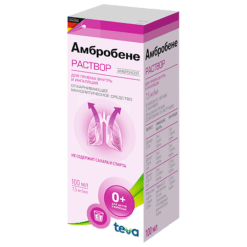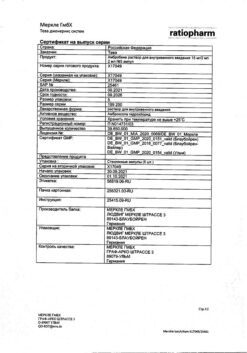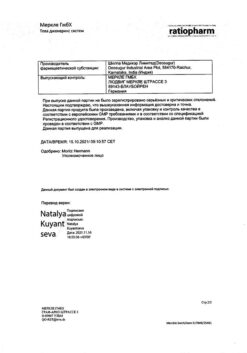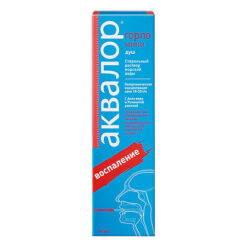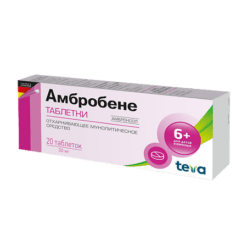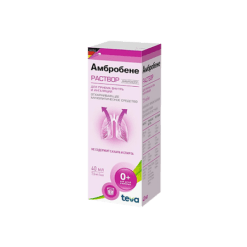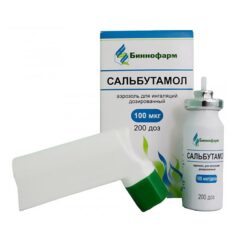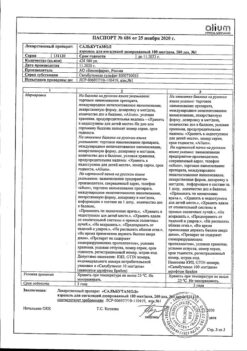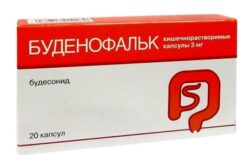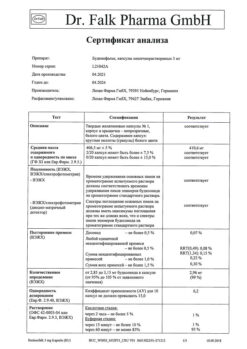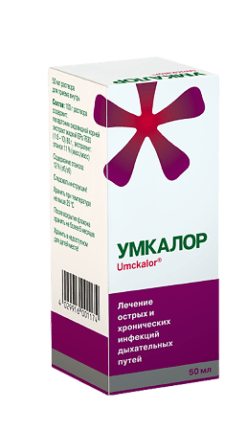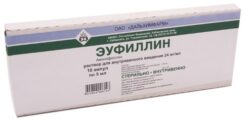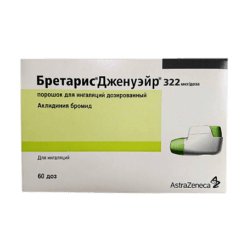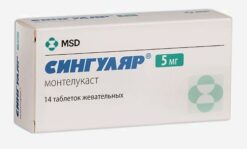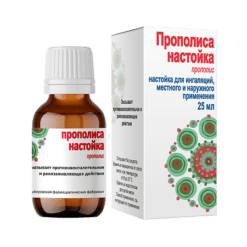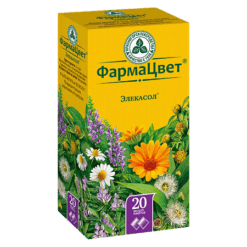No products in the cart.
Ambrobene, syrup 15 mg/5 ml 100 ml
€4.12 €3.67
Description
Pharmacological group: expectorant mucolytic.
ATX code: R05CB06
Pharmacological action
Pharmacodynamics:
Ambroxol is a benzylamine, a metabolite of bromhexine. It differs from bromhexine in the absence of a methyl group and the presence of a hydroxyl group in the para-trans position of the cyclohexyl ring. It has secretomotor and secretolytic and expectorant action.
After oral administration the action comes within 30 minutes and lasts for 6-12 hours (depending on the dose taken).
Preclinical studies have shown that ambroxol stimulates serous gland cells of the bronchial mucosa. By activating cells of the ciliated epithelium and reducing sputum viscosity, it improves mucociliary transport.
Ambroxol activates surfactant formation with a direct effect on alveolar type 2 pneumocytes and small airway Clara cells.
Studies on cell cultures and in vivo animal studies have shown that ambroxol stimulates the formation and secretion of a substance (surfactant) active on the surface of the alveoli and bronchi of the embryo and adult.
An antioxidant effect of ambroxol has also been proven in preclinical studies. Ambroxol when used together with antibiotics (amoxicillin, cefuroxime, erythromycin, doxycycline) increases their concentration in sputum and bronchial secretion.
Pharmacokinetics
Ambroxol is almost completely absorbed from the gastrointestinal tract when taken orally. The maximum concentration is reached 1-3 hours after oral administration. Due to presystemic metabolism the absolute bioavailability of ambroxol after oral administration is reduced by approximately ⅓. The resulting metabolites (such as dibromoanthranilic acid, glucuronides) are eliminated in the kidneys. Binding to plasma proteins is about 85% (80-90%). The plasma elimination half-life is 7 to 12 hours. The total half-life of ambroxol and its metabolites is approximately 22 hours.
It is excreted mainly by the kidneys as metabolites – 90%, less than 10% is excreted unchanged.
Given its high plasma protein binding, large volume of distribution and slow redistribution from the tissues into the blood, there is no significant excretion of ambroxol with dialysis or forced diuresis.
In patients with severe liver disease ambroxol clearance is reduced by 20-40%. In patients with severe renal impairment the half-life of ambroxol metabolites is prolonged.
Ambroxol penetrates the cerebrospinal fluid and through the placental barrier, and is excreted in breast milk.
Indications
Indications
Acute and chronic diseases of the respiratory tract, accompanied by impaired formation and discharge of sputum.
Pharmacological effect
Pharmacological effect
Pharmacological group: mucolytic expectorant.
ATX code: R05CB06
Pharmacological action
Pharmacodynamics:
Ambroxol is a benzylamine metabolite of bromhexine. It differs from bromhexine in the absence of a methyl group and the presence of a hydroxyl group in the para-trans position of the cyclohexyl ring. It has secretomotor and secretolytic and expectorant effects.
After oral administration, the effect occurs within 30 minutes and lasts for 6-12 hours (depending on the dose taken).
Preclinical studies have shown that ambroxol stimulates the serous cells of the glands of the bronchial mucosa. By activating ciliated epithelial cells and reducing sputum viscosity, it improves mucociliary transport.
Ambroxol activates the formation of surfactant, having a direct effect on type 2 alveolar pneumocytes and Clara cells of the small airways.
Studies on cell cultures and in vivo studies on animals have shown that ambroxol stimulates the formation and secretion of a substance (surfactant) active on the surface of the alveoli and bronchi of the embryo and adult.
Also, preclinical studies have proven the antioxidant effect of ambroxol. Ambroxol, when used together with antibiotics (amoxicillin, cefuroxime, erythromycin, doxycycline), increases their concentration in sputum and bronchial secretions.
Pharmacokinetics
When taken orally, ambroxol is almost completely absorbed from the gastrointestinal tract. The maximum concentration is achieved 1-3 hours after oral administration. Due to first-pass metabolism, the absolute bioavailability of ambroxol after oral administration is reduced by approximately ⅓. The resulting metabolites (such as dibromoanthranilic acid, glucuronides) are eliminated in the kidneys. Plasma protein binding is about 85% (80-90%). The plasma half-life ranges from 7 to 12 hours. The total half-life of ambroxol and its metabolites is approximately 22 hours.
It is excreted mainly by the kidneys in the form of metabolites – 90%, less than 10% is excreted unchanged.
Given the high binding to plasma proteins, large volume of distribution and slow redistribution from tissues to blood, significant elimination of ambroxol does not occur during dialysis or forced diuresis.
In patients with severe liver disease, the clearance of ambroxol is reduced by 20-40%. In patients with severe renal impairment, the half-life of ambroxol metabolites increases.
Ambroxol penetrates into the cerebrospinal fluid and through the placental barrier, and is also excreted into breast milk.
Special instructions
Special instructions
It should not be combined with antitussive drugs that impede the removal of sputum.
In children under 2 years of age, the drug can only be used as prescribed by a doctor. Severe skin reactions, such as Stevens-Johnson syndrome and Lyell’s syndrome, have been observed extremely rarely with the use of ambroxol. If there is a change in the skin or mucous membranes, you must immediately consult a doctor and stop taking the drug.
The effect on the ability to drive vehicles and control machines and mechanisms is still unknown.
Caloric content is 2.6 kcal/g sorbitol. Sorbitol may have a mild laxative effect. 1 measuring cup (5 ml of syrup) contains 2.1 g of sorbitol, which corresponds to 0.18 XE.
Active ingredient
Active ingredient
Ambroxol
Composition
Composition
100 ml of syrup contains: active ingredient: ambroxol hydrochloride 0.30 g; excipients: liquid sorbitol 70% 60.00 g, propylene glycol 5.00 g, raspberry flavor 0.10 g, saccharin 0.01 g, purified water 49.44 g.
Pregnancy
Pregnancy
Pregnancy:
There is insufficient data regarding the use of ambroxol during pregnancy. In particular, this applies to the first 28 weeks of pregnancy. Animal studies have not revealed a teratogenic effect.
The use of Ambrobene during pregnancy (II-III trimester) is possible only as prescribed by a doctor, after a careful assessment of the risk/benefit ratio.
Breastfeeding period:
Animal studies have shown that ambroxol passes into breast milk. Due to insufficient study of the use of the drug in women during breastfeeding, the use of Ambrobene is possible only as prescribed by a doctor, after a careful assessment of the risk/benefit ratio.
Contraindications
Contraindications
– hypersensitivity to ambroxol or one of the excipients;
– pregnancy (first trimester);
– sucrase/isomaltase deficiency, fructose intolerance, glucose-galactose malabsorption.
With caution: impaired motor function of the bronchi and increased production of sputum (with fixed cilia syndrome), peptic ulcer of the stomach and duodenum during an exacerbation, pregnancy (II-III trimester), lactation period.
Patients with impaired renal function or severe liver disease should take Ambrobene with extreme caution, observing long intervals between doses or taking the drug in a lower dose.
Side Effects
Side Effects
General violations:
Rarely (from ≥ 0.1% to < 1%): allergic reactions (urticaria, skin rash, angioedema of the face, shortness of breath, itching), fever, weakness, headache.
Very rare (<0.01%): anaphylactic reactions, including anaphylactic shock.
From the gastrointestinal tract:
Rarely (from ≥ 0.1% to < 1%): nausea, abdominal pain, vomiting, diarrhea, constipation.
Others:
Rarely (from ≥ 0.1% to < 1%): dryness of the oral mucosa and respiratory tract, exanthema, rhinorrhea, dysuria.
Interaction
Interaction
With the simultaneous use of ambroxol and antitussives, stagnation of secretions may occur due to suppression of the cough reflex. Therefore, such combinations should be selected with caution.
When ambroxol is taken together with the antibiotics amoxicillin, cefuroxime, erythromycin and doxycycline, the concentration of the latter in sputum and bronchial secretions increases.
Overdose
Overdose
Symptoms:
There were no signs of intoxication with an overdose of ambroxol. There are reports of nervous agitation and diarrhea.
Ambroxol is well tolerated when taken orally at doses up to 25 mg/kg/day.
In case of severe overdose, increased salivation, nausea, vomiting, and decreased blood pressure are possible.
Treatment:
Intensive therapy methods, such as inducing vomiting and gastric lavage, should be used only in cases of severe overdose, in the first 1-2 hours after taking the drug. Symptomatic treatment is indicated.
Storage conditions
Storage conditions
Store out of the reach of children at a temperature not exceeding 25°C.
Shelf life
Shelf life
5 years.
Manufacturer
Manufacturer
Merkle GmbH, Germany
Additional information
| Shelf life | 5 years. |
|---|---|
| Conditions of storage | Keep out of the reach of children at temperatures under 25°C. |
| Manufacturer | Merkle GmbH, Germany |
| Medication form | syrup |
| Brand | Merkle GmbH |
Other forms…
Related products
Buy Ambrobene, syrup 15 mg/5 ml 100 ml with delivery to USA, UK, Europe and over 120 other countries.

